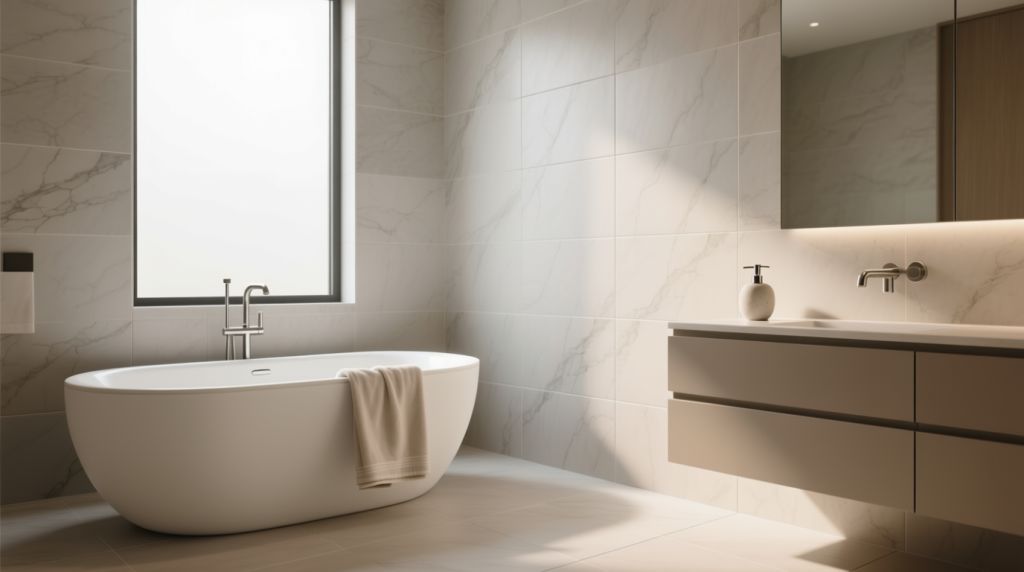
Walk into a newly constructed home, chic office, or trendy café, and you’ll notice a defining feature: surfaces are sleeker, broader, and less cluttered. The era of small, grout-heavy tiles is being overtaken by large format tiles, which offer a blend of elegance and functionality. These tiles are not just a design trend—they’re a practical solution that resonates with the way people live today.
Defining Large Format Tiles
Large format tiles are distinguished by their expansive size, often measuring a meter or more, far larger than the traditional 30x30cm tiles found in older homes. Some resemble full slabs of stone or concrete, creating a bold, seamless look. Once a luxury choice, they’re now widely available in tile shops, used in spaces from residential kitchens to commercial lobbies and outdoor patios.
Why They’re in Demand
The rise of large format tiles aligns with modern design preferences for open, minimalist spaces. Homeowners and designers are moving away from busy, patterned tiles that can make rooms feel smaller. Large tiles create a sense of expansiveness, making spaces feel brighter and more inviting. Their fewer grout lines also mean less cleaning, which is a major draw for busy households or commercial settings.
Practically, they’re low-maintenance. A large tiled surface is easier to keep clean than a grid of small tiles, where grout joints can trap dirt and require constant scrubbing. This makes them ideal for anyone seeking a balance of style and convenience.
Creating a Cohesive Look
The hallmark of large format tiles is their ability to create visual continuity. With minimal grout lines, floors and walls appear as one unbroken surface, enhancing the sense of space. This effect is particularly striking in smaller areas, like bathrooms or compact kitchens, where large tiles can make the space feel significantly larger.
Picture a living room with large format tiles mimicking polished limestone. The smooth, continuous surface feels sophisticated yet practical, offering a modern elegance that’s easy to maintain. Tile shops are seeing increased interest in these tiles for their ability to transform spaces effortlessly.
Design Flexibility
Large format tiles are incredibly versatile, available in finishes ranging from glossy marble to rustic wood effects or industrial concrete looks. Whether you’re designing a sleek urban loft or a cozy suburban home, there’s a tile to match. Tile shops now stock options for every budget, ensuring these tiles are accessible beyond high-end projects.
Their versatility extends to creative applications. Designers use them for statement pieces, like a feature wall in a dining area clad in stone-look porcelain or a shower wall that mimics a single slab of granite. Outdoors, large format pavers create seamless patios or garden paths, blending indoor and outdoor spaces beautifully.
Practical Strengths
Durability is a major advantage. Most large format tiles are made of porcelain, which resists scratches, stains, and moisture, making them perfect for high-traffic areas like hallways or commercial spaces. They also work well with underfloor heating, as their large surface area allows heat to distribute evenly, improving comfort and energy efficiency.
Their longevity adds significant value. A well-installed large tile surface can last decades with minimal upkeep, making it a smart choice for both homes and businesses.
Installation Considerations
Installing large format tiles requires expertise. Their size and weight make them harder to handle than smaller tiles, and they demand a perfectly level surface to avoid unevenness. Tile shops often recommend professional installers who use specialized tools, such as suction cups and leveling systems, to ensure a flawless finish.
For DIY enthusiasts, smaller large-format tiles (like 60x60cm) are more manageable while still delivering the sleek aesthetic. Larger slab-style tiles, however, are best left to professionals to ensure durability and precision.
Cost and Long-Term Value
Large format tiles may carry a higher price per square meter, but their efficiency can offset the cost. Fewer tiles are needed to cover a space, and less grout reduces material and maintenance expenses. Tile shops offer a range of price points, from affordable to premium, making these tiles accessible to a wider audience.
Over time, their durability and low maintenance make them a cost-effective choice, especially for high-use areas like kitchens or commercial floors.
A Reflection of Modern Living
The popularity of large format tiles mirrors how people want to live today. Modern homes prioritize open, low-maintenance spaces that feel timeless yet functional. Large tiles deliver this with their clean aesthetic and practical benefits. While smaller tiles still shine in intricate designs or vintage-inspired spaces, large format tiles dominate for main surfaces like floors and statement walls.
The Future of Tile Design
Tile manufacturers are pushing innovation, creating large format tiles that mimic materials like weathered wood, polished stone, or even metal with remarkable realism. Ultra-thin tiles are also gaining traction, making them easier to install on walls or furniture. As sustainability becomes a priority, large porcelain tiles are valued for their durability, reducing the need for frequent replacements.
Tile shops are expanding their collections to include bolder patterns and textures, especially for outdoor use. The trend toward larger tiles shows no signs of slowing, solidifying their role in modern design.
Closing Thoughts
Large format tiles are more than a design choice—they’re a cornerstone of contemporary interiors. Their blend of style, durability, and versatility makes them ideal for today’s homes and businesses. A visit to a tile shop will reveal why these tiles are shaping the future of design, offering a transformative way to create beautiful, lasting spaces.


